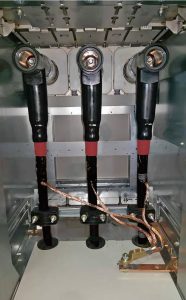How does the 2023 NEC address medium-voltage cable shielding requirements?
Overview
In medium voltage applications, unshielded cables are prone to undesirable phenomena such as surface and corona discharge, leading to potential damage to cable insulation and jacketing. This damage can result in short circuits and other hazards, posing risks to both equipment and personnel. To mitigate these risks and protect valuable equipment and human safety, the NEC 2023 has introduced two new sections, 315.44 and 315.45, outlining the requirements for shielding medium voltage equipment. These additions establish standardized industry-wide guidelines.
damage can result in short circuits and other hazards, posing risks to both equipment and personnel. To mitigate these risks and protect valuable equipment and human safety, the NEC 2023 has introduced two new sections, 315.44 and 315.45, outlining the requirements for shielding medium voltage equipment. These additions establish standardized industry-wide guidelines.
Applying the 2023 Code
Medium-voltage cable shielding serves as a vital protective measure against destructive phenomena such as surface and corona discharge, which can compromise the cable’s insulation and jacketing. Corona discharge, specifically, generates ozone (O3), which can accelerate the aging of the insulation. Shielding can not only confine and disperse electrical stress within the insulation but it can also prevent charging current drain to intermittent grounds, thus enhancing safety by eliminating shock hazards from unshielded cable surfaces. Thus, shielding can reduce the risk of fires, explosions, and radio interference from medium-voltage circuits.
What’s New for the 2023 NEC?
2020 NEC
In the 2020 NEC, the requirements of MV equipment shielding were limited to only MV cables.
2023 NEC
In the 2023 NEC, two new Sections, 315.44 and 315.45, were added to cover the shielding requirements of MV cables, cable joint, and terminals, which now read as follows:
315.44 Shielding
Nonshielded, ozone-resistant insulated conductors with a maximum phase-to-phase voltage of 5000 volts shall be permitted in Type MC cables in industrial establishments where the conditions of maintenance and supervision ensure that only qualified persons service the installation. For other establishments, solid dielectric insulated conductors operated above 2000 volts in permanent installations shall have ozone-resistant insulation and shall be shielded. All metallic insulation shields shall be connected to a grounding electrode conductor, a grounding busbar, an equipment grounding conductor, or a grounding electrode. Equipment grounding conductors installed with circuits using medium voltage cables shall be sized according to 250.190(C).
Informational Note: The primary purposes of shielding are to confine the voltage stresses to the insulation, dissipate insulation leakage current, and drain off the capacitive charging current.
Exception No. 1: Nonshielded insulated conductors listed by a qualified testing laboratory shall be permitted for use up to 2400 volts under the following conditions:
(1) Conductors shall have insulation resistant to electric discharge and surface tracking, or the insulated conductor(s) shall be covered with a material resistant to ozone, electric discharge, and surface tracking.
(2) Where used in wet locations, the insulated conductor(s) shall have an overall nonmetallic jacket or a continuous metallic sheath.
(3) Insulation and jacket thicknesses shall be in accordance with Table 315.10(B).
Exception No. 2: Nonshielded insulated conductors listed by a qualified testing laboratory shall be permitted for use up to 5000 volts to replace existing nonshielded conductors, on existing equipment in industrial establishments only, under the following conditions:
(1) Where the condition of maintenance and supervision ensures that only qualified personnel install and service the installation.
(2) Conductors shall have insulation resistant to electric discharge and surface tracking, or the insulated conductor(s) shall be covered with a material resistant to ozone, electric discharge, and surface tracking.
(3) Where used in wet locations, the insulated conductor(s) shall have an overall nonmetallic jacket or a continuous metallic sheath,
(4) Insulation and jacket thicknesses shall be in accordance with Table 315.10(B).
Informational Note: Relocation or replacement of equipment may not comply with the term existing as related to this exception.
Exception No. 3: Where permitted in 315.36, Exception No. 2.
315.45 Shielding at Type MV Cable Joints and Terminations
Type MV cable joints and terminations shall be provided with means to connect the metallic insulation shield to ground if required.
